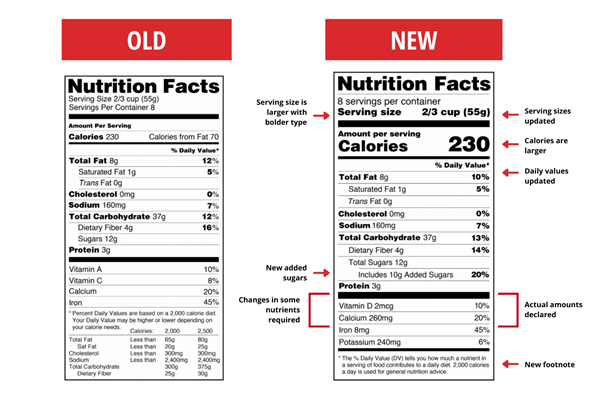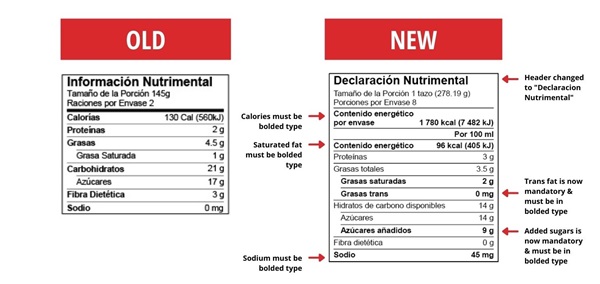Selecteer uw locatie en taal voor de beste website-ervaring

Nutrition Facts labels are essential for consumers when making purchasing decisions, but for food manufacturing companies, the label represents much more than just calorie counts and ingredient lists. While changes to food labeling requirements are infrequent, they can be substantial when they occur. Companies must know how to make an accurate nutrition label while staying informed about regulatory changes that can reduce negative impacts such as fines, recalls, wasted materials, or damage to consumer trust.
Learn more about food labeling software
According to the US Department of Agriculture (USDA), 80% of consumers, or four out of five adults ages 20 and older, regularly refer to the Nutrition Facts on food before making food purchasing decisions. The Nutrition Facts table lists calories, fats, fibers, carbohydrates, and other nutritional information which helps consumers compare products to make healthier choices.
The Food & Drug Administration (FDA) requires Nutrition Facts labels on all packaged foods for manufacturers exporting goods into the US.
Back in 2016, the Nutrition Facts label was updated to call attention to the connection between diet and chronic diseases such as obesity and heart disease, making it easier for consumers to make more informed food choices.
As of January 1, 2020, food and beverage manufacturers with annual US sales exceeding $10 million must comply with new Nutrition Facts label requirements. These updates include a redesigned barcode with bold elements and larger fonts, an updated list of required nutrients and daily values, and revised serving sizes with dual-column labeling for certain package sizes.
To meet these requirements, food manufacturers need a barcode label software solution that can adapt to various label formats and sizes, applying dynamic styling to highlight common food allergens, and providing robust database connections to ensure data accuracy.
Updated Nutrition Facts labels incorporate the following changes:
The US and Canada underwent a transitional period to allow the food and beverage industry time to implement changes introduced in 2016. By now, all manufacturers should be meeting compliance. Meanwhile, Mexico announced changes to their Nutrition Facts label and their transitional period is set to end October 1, 2025.
Food manufacturers must carefully consider the requirements for all three North American countries. While the nutrition labeling regulations share many similarities, they also include some minor differences. Food manufacturers must ensure compliance with labeling requirements in any region where their products are sold.
If nutrition labels are designed incorrectly, the repercussions can be significant for both the food manufacturers and consumers. For manufacturers, inaccurate labels can lead to legal action for “misbranding,” resulting in warnings, product recalls, and fines. For consumers, relying on inaccurate labels could negatively impact their health and their brand loyalty. To ensure your labels are accurate, consider labeling software with built-in label templates to streamline the labeling process.
Below are the requirements for nutrition labels listed out by each North American country.

To learn more about the changes made to the nutrition label in the US, download the Navigating Food Labeling Requirements eBook.


There are three phases for Mexico’s nutrition labeling regulations. Phase 1 and Phase 2 have been defined, and Phase 3 begins on October 1, 2025. Phase 1 required manufacturers to include the new front-of-package (FOP) warning symbols on all product packaging, as well as an updated list of allergens, added sugars and trans-fat as mandatory label nutrients, and modified declarations requirements for voluntary nutrients.
Phase 2 builds on Phase 1 and introduces changes focusing on nutrients in processed foods such as added sugars, fats, and sodium. It also has specific thresholds for excess calories, sugars, fats, or sodium. These must be listed out using warning symbols, which are octagonal, with black and white seals, also known as “sellos”.
Phase 3 maintains nutrient thresholds in Phase 2 but includes new criteria for the warning symbols. If products have added sugars, fats, or sodium, they will need to be assessed for all nutrients of concern, such as Energy (kcal), sugars, saturated fats, trans fats, and sodium.

Examples of warning symbols (sellos) in Mexico
To comply with food labeling standards and create accurate Nutrition Facts labels, it’s essential to choose a software provider with features designed to help you meet specific regulations. By using CODESOFT barcode label design software you can easily make compliant nutrition labels to avoid legal action or fines with the help of:
Learn about more features and food regulations in our Food Labeling White Paper.
If you need to centrally manage your labeling processes, use TEKLYNX CENTRAL and:
TEKLYNX advanced barcode labeling solution, CODESOFT, helps companies easily create, manage, and update Nutrition Facts labels. With the help of nutrition label templates, companies can establish their Nutrition Facts label and select the correct data directly in the software to print accurate labels in accordance with the varying nutrition labeling requirements where products are being sold.
If you are creating Nutrition Facts labels that are more complex and ever-changing you can connect the label template to your preferred database like Access or Excel. Watch the video to learn how to connect an excel spreadsheet or access database to your CODESOFT label template.
If companies follow the correct industry regulations for Nutrition Facts, they can improve their supply chain operations, inventory management, and reduce errors to avoid product recalls. Not only do accurate food labels improve business operations, but consumer safety as well. Choosing a barcode labeling software provider that helps your business meet regulations helps everyone.
TEKLYNX provides software solutions to help simplify the labeling process with label samples and software features. Meet any food and beverage labeling requirement by using CODESOFT. Download a free 30-day trial to start creating and managing your Nutrition Facts labels with CODESOFT or get in touch with a labeling expert if you need help meeting compliance.
Travis Wayne is the Product Manager at TEKLYNX. Travis applies his 20+ years of IT and health sciences experience to empower businesses to streamline operations and barcode better by applying software and technology. He works to continually improve TEKLYNX strategic planning, product and project management principles, and cross-functional communications. When not working, he enjoys many outdoor activities with his wife and two children.
Whether you’re in the food industry or are an avid grocery shopper, you know that barcode labels play an important role on food. From nutrition facts and allergen labeling to food supply chain traceability, the food labeling world is full of information that is necessary for each and every food label is full of necessary information.
READ MORE
When it comes to the food and beverage industry, it is incredibly important to have the best label software in place to ensure efficiency, stability, and peace of mind throughout the supply chain.
READ MORE
In today's health-conscious world, ingredient labels are more than a list of components. They’re a tool for consumer safety, transparency, and trust. According to Food Allergy Research & Education (FARE), every 1 in 10 adults has a food allergy and has experienced a severe reaction. Whether you’re in the food & beverage, cosmetics, cannabis, or pharmaceutical industry, ensuring that your ingredient labels are accurate and compliant with regulatory standards is essential.
READ MORE© Copyright 2025 TEKLYNX CORPORATION SAS. Alle rechten voorbehouden.
What do you think? Leave us a comment.
Comments will be reviewed and are subject to TEKLYNX’ comment policy. Your email address will not be published publicly.